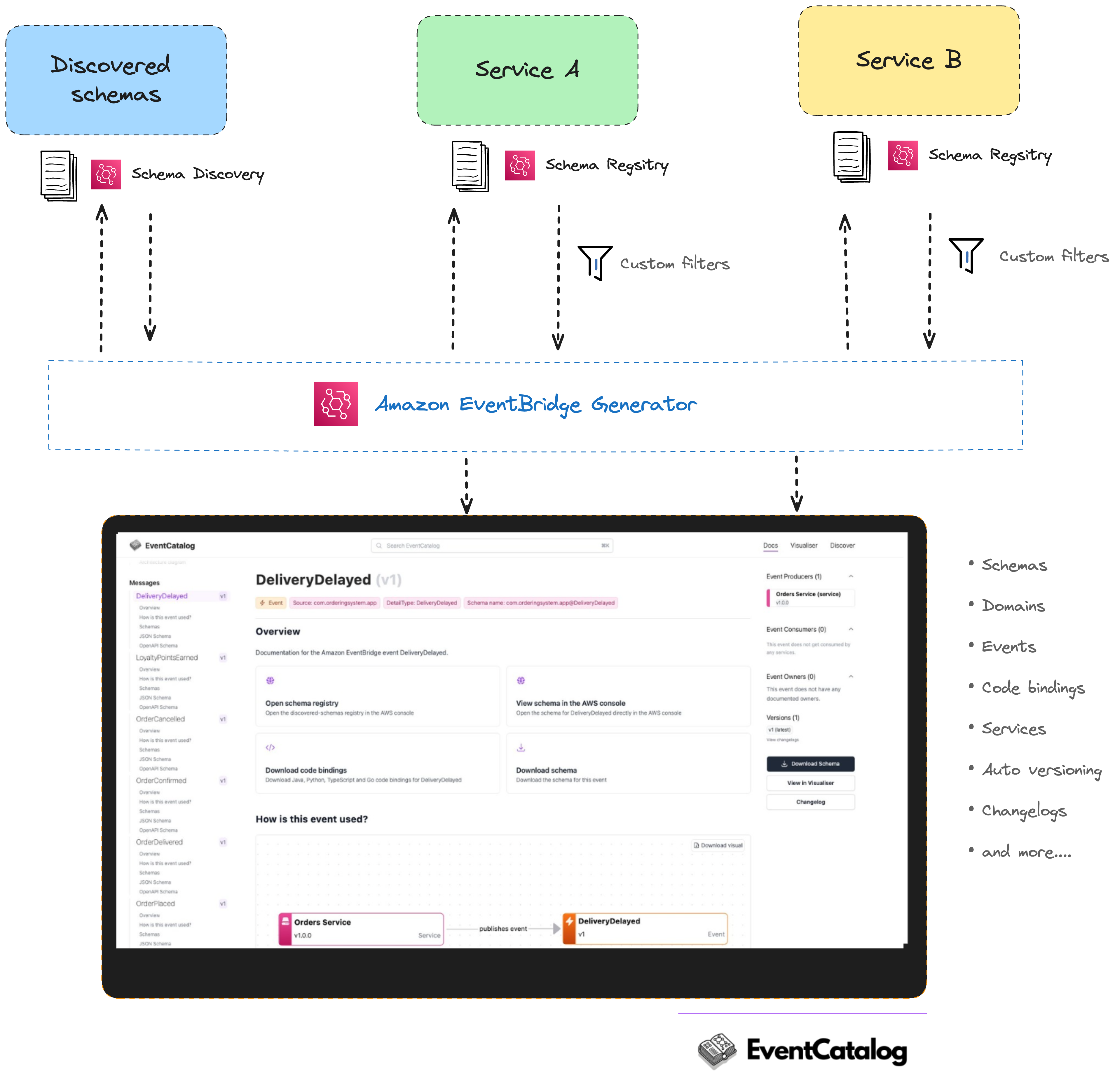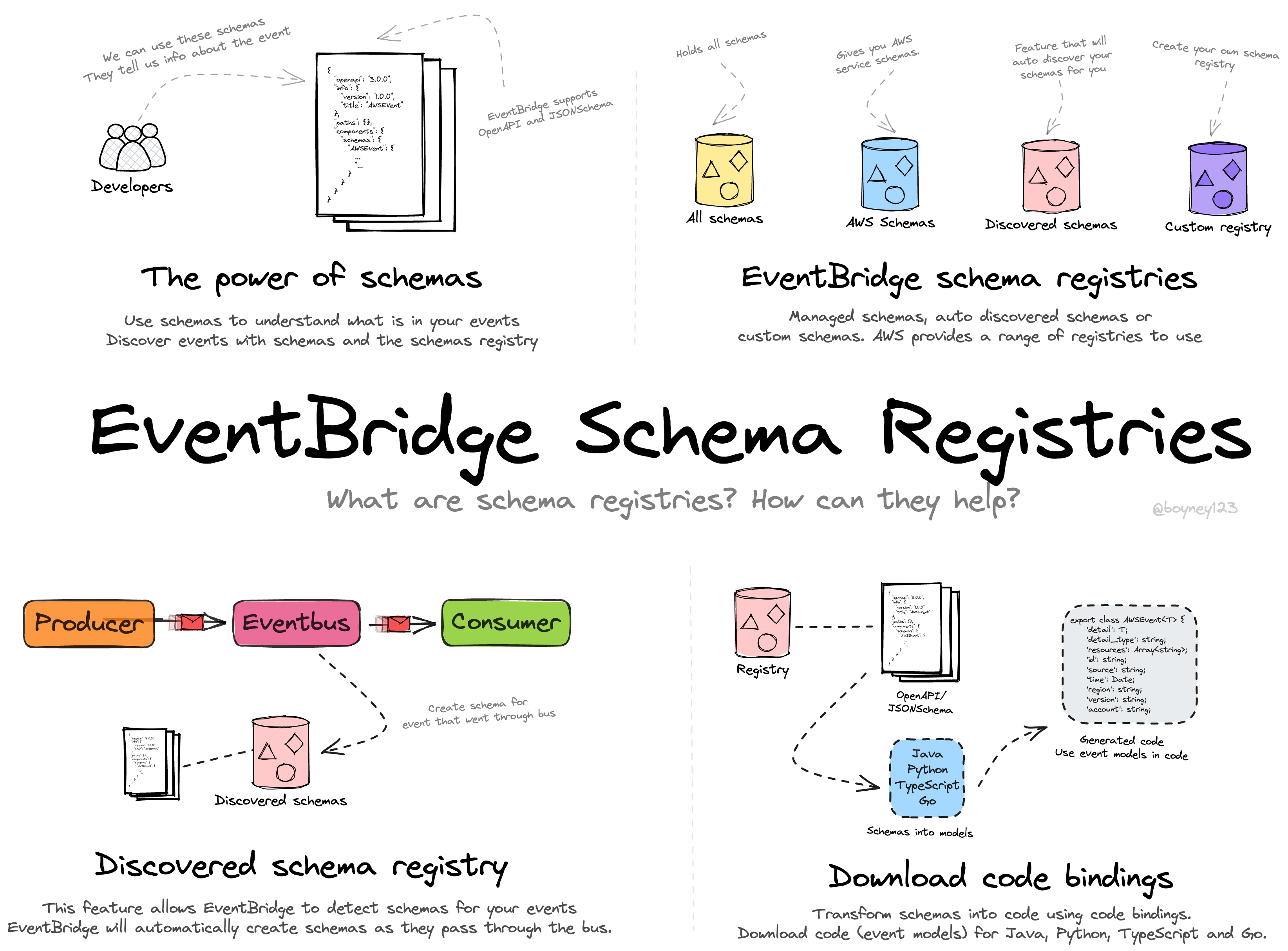Amazon EventBridge integration with EventCatalog
 ;
;
Amazon EventBridge is an AWS service that helps developers build event-driven applications at scale. Amazon EventBridge offers multiple services including Event Bus, Amazon EventBridge Pipes and Amazon EventBridge Scheduler.
At its core, EventBridge's EventBus acts as a central hub where events flow between AWS services and applications.
EventBridge EventBus gives you the ability to define rules and filters that determine where events should go, whether that's to other AWS services or external APIs via API destinations. This flexibility makes it a popular choice when building event-driven architectures on AWS.
One the many challenges developers have with EventBridge is managing event schemas and versioning.
Publishers define the payload of the events for downstream consumers and control how they are versioned. Managing schemas and versions can be challenging as your event-driven architecture grows in your organization but luckily EventBridge provides a schema registry that can help.
Why use the EventBridge schema registry?
The managed schema registry provides developers with useful features that can be used as you build your event-driven architecture. These include the ability to store and download your schemas in JSONDraft or OpenAPI formats, give you the ability to download code models (code bindings) and automatic schema discovery.
When you enable schema discovery, EventBridge will automatically create your event schemas, manage their versions and provide you with a “discovered” schema registry (some say the versioning is aggressive, so you may want to check this and version them yourself anyway by including a version id within your payload).
Although these features can be great (especially as you scale) there are still problems you will encounter. Questions start to emerge within your organization:
- Who is publishing and consuming these events?
- What events do we have?
- Where can I find them?
- Why do they exist?
- What service owns these events?
- Whats the context behind these events?
- How can I version them?
The list goes on.
Schema registry is a great feature, but we believe there is more we can do with our schemas and governance. That’s why we created the EventBridge EventCatalog integration.
Why integrate with Amazon EventBridge with EventCatalog?
EventCatalog helps organizations understand and manage their event-driven architectures by providing comprehensive mapping and documentation of domains, services, and messages.
While schema registries capture the technical contract of events, EventCatalog preserves the crucial context often lost in traditional documentation: ownership details, creation context, schema evolution history, and visual representations of your event flows.
The EventBridge plugin creates a seamless bridge between your AWS Schema Registry and EventCatalog, offering the best of both worlds.
You maintain all the powerful features of EventBridge's schema management while enriching your developer experience with EventCatalogs visualization capabilities, detailed documentation, governance tools, and enhanced discoverability.
This integration helps teams not just track what events exist, but understand how they fit into the broader architectural landscape and how they've evolved over time.
How the plugin works

EventCatalog's plugin system provides powerful integration capabilities, allowing teams to connect with any external API, system, or specification file. Through its SDK, developers gain programmatic access to their catalogs, enabling custom scripts and automation that fit their specific needs.
The EventBridge plugin maps your AWS events into logical domains and services using customizable filters. Teams can define precise mapping rules based on event prefixes, suffixes, detailTypes, and sources, creating clear boundaries around which events each service produces or consumes.
When EventBridge events are mapped into EventCatalog, they become more than just technical schemas - they gain rich contextual information that helps teams understand their broader impact. This includes crucial details like event ownership, business context, and the producer-consumer relationships.
What makes this particularly powerful is how EventCatalog handles schema versioning. As your events evolve and schemas update, all this valuable context persists. Your team's documentation, ownership details, and relationship mappings carry forward with each new version, creating a living history of the event's purpose and impact. This persistent context helps developers and teams make informed decisions, quickly identify event owners, and understand downstream impacts of changes.
If you want to gain more value from your EventBridge schema registries you can get started by reading the plugin documentation.
Summary
Amazon EventBridge is a popular service to build event-driven architectures on AWS. We created our EventBridge integration to help you get more value from your schema registries.
The EventBridge plugin allows you to map your events (with custom filters) into domains and services within your organiszation and help your developers understand how your events are being produced and consumed.
EventCatalog syncs with your schema registry and will persist any additional contextual information you add to your events including producers, consumers, services, domains and ownership.
Getting started should take a few minutes and you can read our guide here.
If you have any questions you can join us on our Discord server.
